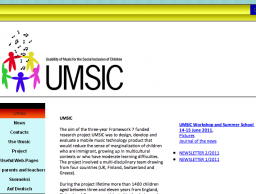Share:



Classification:
Educational music-oriented collaborative environments
Country:
Description:
The Usability of Music for the Social Inclusion of Children (UMSIC) project, run between September 2008 and August 2011, investigated the use of modern music and mobile technology to promote a greater sense of inclusion for children aged three to 12 years across Europe, especially those who may be in danger of marginalisation. The intention was to develop music software that could be used easily by children (including those that fell into the two target groups) in a variety of contexts such as at school and at home. Funded as an ICT collaborative project by the European Commission under the Seventh Research Framework Programme [Grant FP7-ICT-2007-2], the UMSIC project brought together a team of musicians, software designers, technologists, engineers, psychologists and educators from across Europe with additional support from Nokia.
One of the main outcomes was JamMo 1.0, a music-making game targeted at children aged between three and 12years. It was released in July 2011 following three years of research, design and development. Two packages, JamMo 3 to 6 and 7 to 12, make use of an extensive library of specially prepared musical materials for singing, composition and sequencing produced by members of the UMSIC team in collaboration with 23 professional instrumentalists and singers in Finland and the UK.
Target Group:
The UMSIC project targeted two main groups of children deemed to be at particularly high risk. These included newly migrant children growing up in bi-cultural contexts and children with moderate learning difficulties (such as attention deficit disorders) [cf UNESCO, 2010].
Technology:
MAIN PORTAL: Joomla (PHP, MYSQL).
TOOLS:
- Juke box: Joomla extension: Pro Magic Audio Player
- Song bank & sound and loop bank: Joomla extension: Music Collection Module
- Discussion forum: Joomla Bulletin Board
- Offline (JamMo): The project was carried out on mobile devices. The main interaction system makes extensive use of JSON (javascript object notation) and the Engineering and Authoring modules are bespoke and built using GObject, a free software library providing a portable object system and transparent cross-language interoperability.
Source: This information was gleaned from documentation available online.
Usability and Accessibility:
The UMSIC project was materialized through the release of a program called Jammo, run primarily on Nokia mobile devices featuring touch interfaces, but also made available in a later phase of the project for Ubuntu (Linux) desktop computers. The activities offered by Jammo consist in games involving music creation of memory training for younger pupils (ages 3-12). The focus of these games seems to have been put on the intuitive use of the tool’s features with the help of a simplistic interface supported by cartoon-like characters and other graphic elements. Besides the pro-active activities of Jammo which introduce pupils to music creation standard processes and automatisms, the platform also includes a community where users have a profile where they may share their creations and results.
Deploying Jammo to a mobile platform featuring a touch interface seems like a very considerate choice in regard to the familiarity of younger students with such devices, or the need to become familiarized with them as their use rises exponentially. Such devices are designed with usability and accessibility perspectives set to the fore, and the limitations in regard to application developments on mobile platforms are usually at the benefit of user-friendliness, intuitive interfacing, and functionality efficiency. We may however wonder why development was targeted at two specific Nokia devices as a unique physical platform, since the specifications of the compatible units do not seem to be the most suited for digital music creation, one of which is even described in Jamo’s documentation as having too much latency to be used with several of the available activities.
Link:


